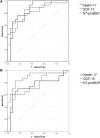Apelin-17 to diagnose idiopathic pulmonary arterial hypertension: A biomarker study
- PMID: 36685176
- PMCID: PMC9846527
- DOI: 10.3389/fphys.2022.986295
Apelin-17 to diagnose idiopathic pulmonary arterial hypertension: A biomarker study
Abstract
Background: NT-proBNP and GDF-15 are established blood-derived biomarkers for risk assessment in pulmonary hypertension (PH), despite limited sensitivity and specificity. Apelin has a crucial function in endothelial homeostasis, thus it might represent a new biomarker for PH. However, there are numerous circulating apelin isoforms, and their potential role in this setting is unknown. This study evaluated different apelin isoforms in PH patients and prospectively evaluated the role of apelin-17 in comparison with NT-proBNP and GDF-15 as diagnostic marker in idiopathic pulmonary arterial hypertension (IPAH). Methods: Based on our pilot study, we performed a power calculation for apelin-13, apelin-17, apelin-36, as predictor of IPAH vs healthy controls. Apelin-17 provided the best discriminatory power, and accordingly, we enrolled n = 31 patients with IPAH and n = 31 matched healthy controls in a prospective study. NT-proBNP and GDF-15 was determined in all patients. ROC curve analysis was performed to assess the diagnostic value of the markers and their combinations. Results: Apelin-17, NT-proBNP, and GDF-15 were significantly elevated in IPAH patients as compared to controls (p < .001). Apelin-17 detected IPAH with a sensitivity of 68% and a specificity of 93% at a cut-off value of >1,480 pg/ml (AUC 0.86, 95%CI:0.76-0.95) as compared to GDF-15 (sensitivity 86%; specificity 72%, AUC 0.81 (95%CI:0.7-0.92)) and NT-proBNP (sensitivity 86%; specificity 72% (AUC 0.85, 95%CI:0.75-0.95)). Combinations of these markers could be used to increase either specificity or sensitivity. Conclusion: Apelin-17 appears to be suitable blood derived diagnostic marker for idiopathic pulmonary arterial hypertension.
Keywords: GDF-15; NT-proBNP; apelin-17; blood derived biomarker; diagnosis; idiopathic pulmonary arterial hypertension.
Copyright © 2023 Foris, Kovacs, Avian, Bálint, Douschan, Ghanim, Klepetko, Olschewski and Olschewski.
Conflict of interest statement
The authors declare that the research was conducted in the absence of any commercial or financial relationships that could be construed as a potential conflict of interest.
Figures


References
LinkOut - more resources
Full Text Sources
Research Materials

